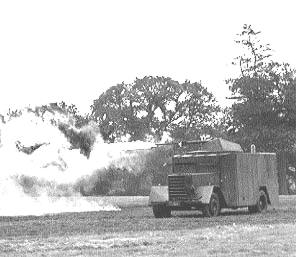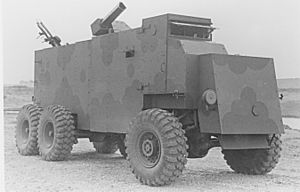Lagonda flamethrower facts for kids
During World War II, the Lagonda company made several types of flamethrowers. These were special weapons that shot out a stream of fire.
At first, these flamethrowers were developed to defend against possible German attacks. People thought they would scare away Luftwaffe dive bombers trying to hit lightly protected British Merchant Navy ships and coastal bases. The British Navy and Army worked together on these projects. Later, Lagonda also made flamethrowers to be put on armored vehicles.
History of Flamethrowers
After British soldiers were evacuated from Dunkirk, it looked like Germany might invade the United Kingdom. Because of this, flamethrowers were seen as a good defensive weapon. The Petroleum Warfare Department was set up to work on these.
Instead of regular gasoline, a thicker fuel was created. This new fuel was safer to handle with pumps. To test it, a Commer truck was changed by the Lagonda Car Company. It carried a special turret with a flamethrower.
Another flamethrower, called the "Heavy Pump Unit," was made by AEC. This used a large six-wheel truck. The Heavy Pump Unit had two flamethrowers. The main one was in a turret and could shoot fire up to 300 feet high. This was meant for shooting at aircraft. The other flamethrower was on a separate carriage.
The same AEC truck was used for the "Heavy Cockatrice" by the Petroleum Warfare Department and Lagonda. A smaller version, called the "Bedford Cockatrice," was built on a Bedford QL truck chassis. AEC also made a similar vehicle called the "Basilisk" using their AEC Matador truck.
For attacking, a tracked vehicle was better than a truck. A Universal Carrier was used for a prototype. This led to Canada becoming interested. With Lagonda's help, Canada made its own flamethrower design. It could fire flame 40 yards and was called "Ronson."
Lagonda also worked with Major Oke to create a flamethrower that could be put on a tank. This flamethrower used the tank's extra fuel tank for its fuel. It was planned for use in the Dieppe Raid.
After the Ronson project went to Canada, Lagonda worked on its own flamethrower for the Universal Carrier. This was called the Wasp. Two versions were made. The second version could shoot fire over 100 yards.
For fighting in the jungles of Burma, a tank-mounted flamethrower was very useful. The Churchill Crocodile tank flamethrower was not ideal because its fuel and gas were in a trailer. An internal system, called "Salamander," was not good enough. So, Lagonda developed an external system. This was called "Adder" if put on a Sherman tank or "Cobra" if put on a Churchill tank.
An 80-gallon armored fuel tank was placed at the back of the tank. The fuel went along the outside of the tank to a flamethrower at the front. The co-driver controlled it. The Adder could shoot fire 100 yards using an inert gas to push the fuel.
How They Worked
The main idea was to create a weapon that could shoot a jet of flame high and wide. This would force enemy bomber pilots to either pull out of their dive or fly through fire. Flying through fire could damage or destroy their plane.
Many designs were suggested. Experts from the Anglo-Iranian Oil Company checked if the plans would work. Military engineers then built prototypes of the best designs. After testing, they showed these weapons to admirals and generals.
The most effective design came from the Lagonda car company. It fired eight gallons of a diesel oil and tar mixture every second. This created a continuous stream of flame with a range of almost 100 feet (30 m). At its widest, the flame was about 30 feet (9 m) across.
According to Gerald Pawle, an engineer on the project, the Lagonda flamethrower amazed and scared everyone who saw it. Later improvements increased its range to 200 feet (61 m). However, much more fuel was needed to keep the flame going for a long time.
Testing and Use
A test was done at sea to see if the weapon would scare away German aircraft. A prototype flamethrower was put on a French fishing boat called La Patrie. It was set up to fire straight up.
When the RAF pilot arrived for the test, the team worried the weapon would be too effective. They told him exactly what would happen. The test results were not very good. The pilot made his first fake attack without getting too close. But on later tries, he flew closer and closer, almost into the flame.
The pilot said the weapon was not a good deterrent. However, he admitted that knowing about the test might have changed his behavior. So, a second test was arranged with a different pilot. This pilot was told nothing about what to expect.
The results were similar. The pilot did not stop his attack. He even brushed his wing into the flame. Later, it was found that this pilot had worked in a circus before the war. He used to drive cars through rings of fire!
Thinking that the German air force would not have many circus drivers, limited production of the Lagonda naval flamethrower began. These weapons were put on coaster ships working near the River Thames. Ship captains liked the flamethrowers at first. But they soon found out the weapons needed a lot of maintenance. Also, the crew had to be careful not to get covered in tar.
These flamethrowers did not cause any confirmed enemy deaths during the war. However, British intelligence found that the weapons had two effects on the German forces. First, the Germans started testing similar naval flamethrowers. These also had problems, with officers getting covered in oil during tests. Second, partly because of the Lagonda flamethrower and other defense systems, German bombers started attacking merchant ships from higher altitudes. They flew well above 200 feet, which made it harder for their bombs to hit.
In Action
The Bedford Cockatrice was ordered to defend coastal bases of the Fleet Air Arm. These bases were worried about German glider or parachute troops invading. It was thought that these troops would need about one minute to get ready after landing. So, the Cockatrice was seen as a fast-response vehicle. It could kill or scare small enemy forces into surrendering. Sixty Cockatrice vehicles were built and used at Royal Navy Air Stations. The RAF received six Heavy Cockatrice vehicles for airfield defense.
Three Churchill tanks, fitted with the Oke flamethrower, were used during the Dieppe Raid.
See also
- Flamethrower, Portable, No 2, or "Ack-pack", a portable flamethrower used by British infantry in the same period.
- Churchill Crocodile
- List of flamethrowers



